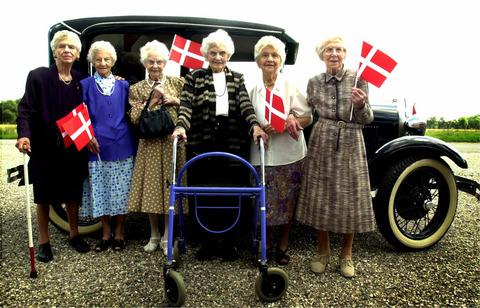当前位置:
X-MOL 学术
›
Aging Cell
›
论文详情
Our official English website, www.x-mol.net, welcomes your feedback! (Note: you will need to create a separate account there.)
Mechanisms underlying familial aggregation of exceptional health and survival: A three-generation cohort study.
Aging Cell ( IF 7.8 ) Pub Date : 2020-09-04 , DOI: 10.1111/acel.13228 Kaare Christensen 1 , Mary K Wojczynski 2 , Jacob K Pedersen 1 , Lisbeth A Larsen 1 , Susanne Kløjgaard 1 , Axel Skytthe 1 , Matt McGue 1, 3 , James W Vaupel 4 , Michael A Province 2
Aging Cell ( IF 7.8 ) Pub Date : 2020-09-04 , DOI: 10.1111/acel.13228 Kaare Christensen 1 , Mary K Wojczynski 2 , Jacob K Pedersen 1 , Lisbeth A Larsen 1 , Susanne Kløjgaard 1 , Axel Skytthe 1 , Matt McGue 1, 3 , James W Vaupel 4 , Michael A Province 2
Affiliation

|
The familial resemblance in length of adult life is very modest. Studies of parent‐offspring and twins suggest that exceptional health and survival have a stronger genetic component than lifespan generally. To shed light on the underlying mechanisms, we collected information on Danish long‐lived siblings (born 1886–1938) from 659 families, their 5379 offspring (born 1917–1982), and 10,398 grandchildren (born 1950–2010) and matched background population controls through the Danish 1916 Census, the Civil Registration System, the National Patient Register, and the Register of Causes of Death. Comparison with the background, population revealed consistently lower occurrence of almost all disease groups and causes of death in the offspring and the grandchildren. The expected incidence of hospitalization for mental and behavioral disorders was reduced by half in the offspring (hazard ratio 0.53, 95% confidence interval 0.45–0.62) and by one‐third in the grandchildren (0.69, 0.61–0.78), while the numbers for tobacco‐related cancer were 0.60 (0.51–0.70) and 0.71 (0.48–1.05), respectively. Within‐family analyses showed a general, as opposed to specific, lowering of disease risk. Early parenthood and divorce were markedly less frequent in the longevity‐enriched families, while economic and educational differences were small to moderate. The longevity‐enriched families in this study have a general health advantage spanning three generations. The particularly low occurrence of mental and behavioral disorders and tobacco‐related cancers together with indicators of family stability and only modest socioeconomic advantage implicate behavior as a key mechanism underlying familial aggregation of exceptional health and survival.
中文翻译:

异常健康和生存的家族聚集机制:一项三代队列研究。
成年寿命长度的家族相似性非常小。对父母子女和双胞胎的研究表明,与一般寿命相比,卓越的健康和生存具有更强的遗传因素。为了阐明潜在机制,我们收集了来自 659 个家庭的丹麦长寿兄弟姐妹(1886-1938 年出生)、他们的 5379 名后代(1917-1982 年出生)和 10,398 名孙子(1950-2010 年出生)以及匹配的背景人口的信息通过丹麦 1916 年人口普查、民事登记系统、国家患者登记册和死因登记册进行控制。与背景相比,人口显示几乎所有疾病组的发生率以及后代和孙辈的死亡原因始终较低。后代因精神和行为障碍住院的预期发生率减少了一半(风险比 0.53,95% 置信区间 0.45-0.62),孙辈则减少了三分之一(0.69,0.61-0.78),而与烟草相关的癌症分别为 0.60 (0.51–0.70) 和 0.71 (0.48–1.05)。家庭内分析显示疾病风险总体降低,而非具体降低。在长寿的富裕家庭中,早育和离婚的发生率明显较低,而经济和教育差异则较小到中等。本研究中的长寿家庭在三代人中都具有总体健康优势。精神和行为障碍以及与烟草相关的癌症的发生率特别低,加上家庭稳定性指标和仅有适度的社会经济优势,表明行为是家庭异常健康和生存的关键机制。
更新日期:2020-10-23
中文翻译:

异常健康和生存的家族聚集机制:一项三代队列研究。
成年寿命长度的家族相似性非常小。对父母子女和双胞胎的研究表明,与一般寿命相比,卓越的健康和生存具有更强的遗传因素。为了阐明潜在机制,我们收集了来自 659 个家庭的丹麦长寿兄弟姐妹(1886-1938 年出生)、他们的 5379 名后代(1917-1982 年出生)和 10,398 名孙子(1950-2010 年出生)以及匹配的背景人口的信息通过丹麦 1916 年人口普查、民事登记系统、国家患者登记册和死因登记册进行控制。与背景相比,人口显示几乎所有疾病组的发生率以及后代和孙辈的死亡原因始终较低。后代因精神和行为障碍住院的预期发生率减少了一半(风险比 0.53,95% 置信区间 0.45-0.62),孙辈则减少了三分之一(0.69,0.61-0.78),而与烟草相关的癌症分别为 0.60 (0.51–0.70) 和 0.71 (0.48–1.05)。家庭内分析显示疾病风险总体降低,而非具体降低。在长寿的富裕家庭中,早育和离婚的发生率明显较低,而经济和教育差异则较小到中等。本研究中的长寿家庭在三代人中都具有总体健康优势。精神和行为障碍以及与烟草相关的癌症的发生率特别低,加上家庭稳定性指标和仅有适度的社会经济优势,表明行为是家庭异常健康和生存的关键机制。


























 京公网安备 11010802027423号
京公网安备 11010802027423号